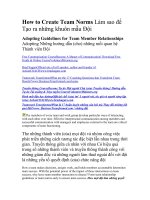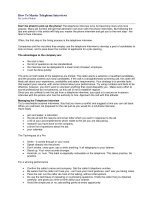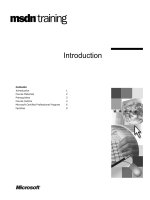How to study enghlish 7 pdf
Bạn đang xem bản rút gọn của tài liệu. Xem và tải ngay bản đầy đủ của tài liệu tại đây (69.19 KB, 6 trang )
HOW TO STUDY
16
Creative Thinking
If you’re a right-brain thinker, you’re probably pretty good at coming up
with ideas.
If this is you:
• Use your imagination. Pretend the text is a speech or a play and
you’re the announcer or actor. Come up with your own ideas on
this!
Rhythm
Musical rhythms, songs, or the beats in poetry come easily to you.
If this is you:
• Tap your foot or fingers as you read your text as if it were a song
or poem. This works with numbers, too.
Art
You like to look at or make drawings, sculptures, or paintings.
If this is you:
• Draw pictures of what something you’re reading means to you.
Turn the text into your own cartoon.
You’ve come a long way already. Now you know which side of the
brain dominates your thinking and you have used that knowledge to find
learning styles that will help you learn more efficiently. In the next three
chapters, you’ll be exploring those styles, one by one.
WHAT IF ENGLISH ISN’T YOUR FIRST
LANGUAGE?
O.K. Now you have a general idea of what your learning styles are. But
you spoke another language before you learned English. Reading in
English takes a little longer than reading in your native language. Some
native English speakers talk a little too fast for you to understand them.
What can you do?
The trickiest part of learning a new language is the simplest. CLOSE
YOUR EYES. Let your ears do the work. No matter what kind of a learner
DISCOVERING HOW YOU LEARN
17
you are, you learned your native language by listening. That’s why a
native language is sometimes called a “mother tongue,” because the first
sounds a baby hears, the first words a baby hears, are usually from the
mother.
Do you like to watch television? Close your eyes. Let your ears do the
work of understanding what’s happening. It can be easy to figure out
what is happening just by looking.
• If you learn best by hearing, maybe you are already comfortable
speaking—and listening—to English. Maybe you are more
concerned with reading, and writing, in English.
• If you learn best by seeing, maybe you are more comfortable
reading English than you are speaking it. Maybe you are more
concerned with speaking in English.
S
EEING + HEARING
= UNDERSTANDING
The more you see and hear English at the same time, the more readily
you’ll be able to read and write in English! Check out your school or local
library for subtitled films. When you see the words you’re hearing, you’ll
become more familiar with them. (Occasionally, a sentence is written in
subtitles shorter than it’s spoken on the screen. When this is done, the
meaning remains the same.) You may be able to get close-captioning—
subtitles embedded in the broadcast signal—for your home television,
too.
The more you speak English, the easier it is to write it. By being famil-
iar with the way English sounds, we know where words and punctuation
marks go. Punctuation is based on where we pause (comma) and where
we stop (period) when we speak. How can you put yourself in situations
where you’ll speak English more often? Look into clubs at school or in
your neighborhood, where people with a similar hobby or interest get
together. And, remember to have fun!
HOW TO STUDY
18
I
N SHORT
You learn from your eyes, ears, by making images, by putting ideas in
order, and by doing. You have your own combination of learning styles.
Things you like to do for fun, and the ways you do them, can help show
you what your learning styles are. And, as you know by now, you get
more out of studying when you use the ways you learn best.
Practice Tips
Think back, then write the answers to these questions in your note-
book.
• Who were your favorite teachers?
• How did your favorite teachers address your learning style?
• What did they do to help you learn?
19
CHAPTER
3
LOOKING AND
LISTENING
The eyes have it—and so
do the ears. These are the
two most common study
styles. Is one of them your
strongest? Whether you
answer yes or no, you
probably use both
styles often. In this chapter,
you’ll learn how to make
the most of what you see
and what you hear.
I
n Chapter 2, you began to discover your
own learning styles by looking at what you like to do and what
comes to you easily. You looked at five different styles, and you
probably found that one or two of them are most important to you.
This chapter concentrates on two of those styles: using your eyes and
using your ears. Most people find that they rely heavily on one or the
other of these–even people who also rely on images, order, or doing to
help them learn.
Matching the Situation with Your Learning Style
Jonah and Mike are both studying Public Speaking. Jonah learns
better by hearing, and Mike learns better by seeing. When
responding to speeches by classmates, Jonah listens carefully, giv-
ing the speaker his full attention, and Mike tries to write as much
as he hears, underlining what’s important or interesting to him.
Mike also pays attention to visual aids, such the blackboard or
handouts. Both Jonah and Mike give similar responses to the
speaker, but they have to focus on the speech in very different
ways. If Jonah just wrote notes, and Mike just listened, they both
would have a problem understanding what the speech was
about.
HOW TO STUDY
20
EYES OR EARS
Few people actively use both their eyes and their ears in learning new
things. One or the other is usually much stronger. In this chapter, you’ll
continue to explore whether you are more a visual or an auditory learn-
er. Once you’ve done that, you’ll learn study tips that will help you take
advantage of your strength and help you learn to use the weaker learning
style. After all, you sometimes have to use a style that’s not your strongest.
If you’re listening to a tape or a lecture, you have to use your ears,
whether you’re an auditory learner or not. If you’re reading or making an
observation, your eyes play the lead role, whether you’re a visual learner
or not. So while you can learn to take advantage of your strong side, you
have to learn to use your weaker side as well.
In this chapter, you’ll find out how to make more of seeing and
hearing–both by using your own learning strength, and by finding ways
to work within a situation that doesn’t cater to your predominant style.
D
O
YOU SEE OR HEAR BETTER?
Imagine running into a friend you haven’t seen for a long time. The
friend is in a hurry to catch a bus. Neither one of you has paper or pen.
The friend tells you his phone number. What do you do to try to
remember the number?
Imagine you’re traveling by bus to a town you haven’t been to
before. You pass a billboard with important hotel and restaurant infor-
Find Out!
LOOKING AND LISTENING
21
mation. You don’t have paper and pen with you. What do you do to try
to remember what’s on the billboard?
Which exercise above came more naturally to you?
• Was it the phone exercise? If so, you probably learn better by hear-
ing.
• Was it the billboard exercise? Then you probably learn better by
seeing.
• Were the two exercises the same for you? Yes? Then you probably
learn better when you see and hear something at the same time.
B
OOST YOUR
EYE OR EAR POWER
OK, now that you know whether you learn better with your ears or your
eyes, what do you do to study more effectively? Whether you’re summa-
rizing what you read, or reflecting on what happened in the last class, try
one of these techniques:
• Give yourself something to hear: speak! Take notes by speaking
into a tape recorder. You can play this back not only at your best
study time (see Chapter 1), but in a headset when you’re commut-
ing to or from work, when you’re on your lunch hour, doing dish-
es at home, or going for a walk.
• Give yourself something to see: write or draw! Carry a little note-
book or sketch pad around with you to write or draw after-
thoughts of what you studied. You can study not only at your best
time of day, but since you’re carrying your notes with you, when-
ever you have a few minutes–even in the bathtub.
BE ALL EARS
Here are ways to make the most of using your ears in studying, whether
they’re your learning strength or not.
WHEN LISTENING
Use only your ears. Try closing your eyes when you’re listening to some-
thing you want to remember, whether it’s a tape of a speech or notes









